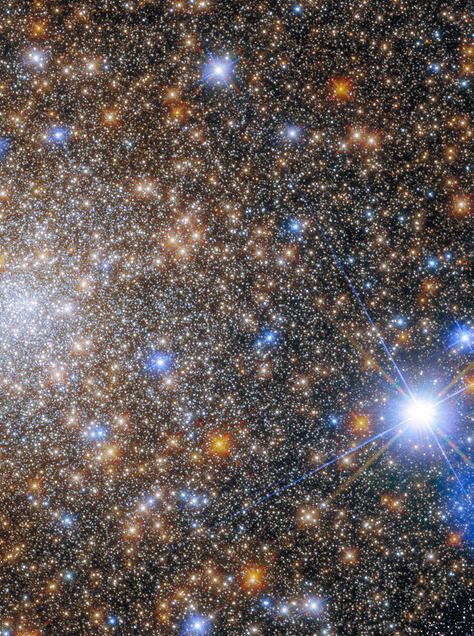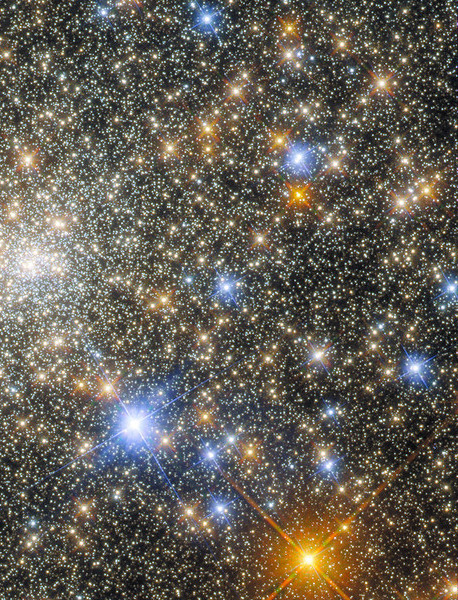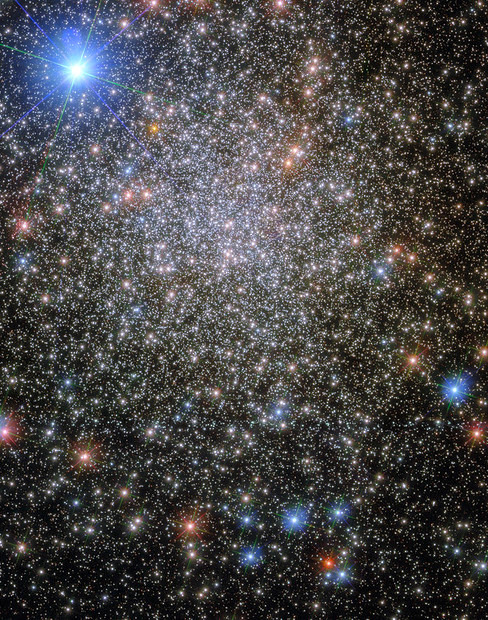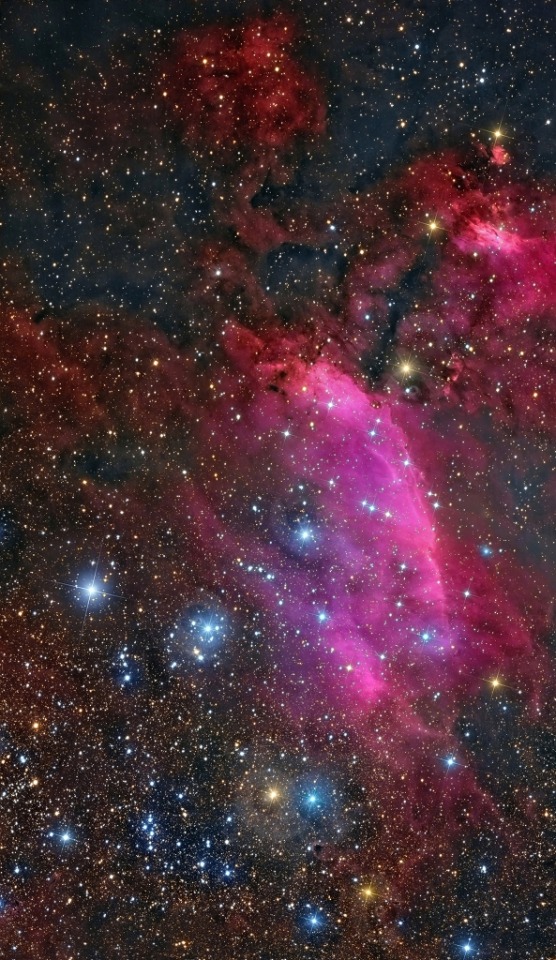Wide-Field Spiral

Wide-Field Spiral
More Posts from Ad-astra-affecte-spe and Others

2023 December 16
Crescent Enceladus Image Credit: Cassini Imaging Team, SSI, JPL, ESA, NASA
Explanation: Peering from the shadows, the Saturn-facing hemisphere of tantalizing inner moon Enceladus poses in this Cassini spacecraft image. North is up in the dramatic scene captured during November 2016 as Cassini’s camera was pointed in a nearly sunward direction about 130,000 kilometers from the moon’s bright crescent. In fact, the distant world reflects over 90 percent of the sunlight it receives, giving its surface about the same reflectivity as fresh snow. A mere 500 kilometers in diameter, Enceladus is a surprisingly active moon. Data and images collected during Cassini’s flybys have revealed water vapor and ice grains spewing from south polar geysers and evidence of an ocean of liquid water hidden beneath the moon’s icy crust.
∞ Source: apod.nasa.gov/apod/ap231216.html

Ring of Fire October 2023 l Bray Falls


Sagittarius dwarf irregular galaxy (sagDIG) © Hubble
A universe in motion seen from the International Space Station during a night pass over Earth.
(@ wonderofscience on Twitter)
Timelapse created from images courtesy of the Earth Science and Remote Sensing Unit, NASA Johnson Space Center(ISS061-E-110520-111341 eol.jsc.nasa.gov).


Galaxies can merge, collide, or brush past one another — each of which has a significant impact on their shapes and structures. As common as these interactions are thought to be in the Universe, it is rare to capture an image of two galaxies interacting in such a visibly dynamic way. This image, from the NASA/ESA Hubble Space Telescope, feels incredibly three-dimensional for a piece of deep-space imagery.
The subject of this image is named Arp 282, an interacting galaxy pair that is composed of the Seyfert galaxy NGC 169 (bottom) and the galaxy IC 1559 (top).
Credits: ESA/Hubble & NASA, J. Dalcanton, Dark Energy Survey, J. Schmidt

NGC 5189
NGC 5189 is a planetary nebula in the constellation Musca. It was discovered by James Dunlop on 1 July 1826, who catalogued it as Δ252. For many years, well into the 1960s, it was thought to be a bright emission nebula. It was Karl Gordon Henize in 1967 who first described NGC 5189 as quasi-planetary based on its spectral emissions
-
 lafrutta liked this · 1 year ago
lafrutta liked this · 1 year ago -
 ad-astra-affecte-spe reblogged this · 2 years ago
ad-astra-affecte-spe reblogged this · 2 years ago -
 zealousstudentpartycookie liked this · 2 years ago
zealousstudentpartycookie liked this · 2 years ago -
 barnabusstuff liked this · 2 years ago
barnabusstuff liked this · 2 years ago -
 lunch-leviathan liked this · 2 years ago
lunch-leviathan liked this · 2 years ago -
 whither-the-wind-goes liked this · 2 years ago
whither-the-wind-goes liked this · 2 years ago -
 liiyre reblogged this · 2 years ago
liiyre reblogged this · 2 years ago -
 aanxii reblogged this · 2 years ago
aanxii reblogged this · 2 years ago -
 theradiodemon7 liked this · 2 years ago
theradiodemon7 liked this · 2 years ago -
 mewtwowarrior liked this · 2 years ago
mewtwowarrior liked this · 2 years ago -
 southofzero reblogged this · 2 years ago
southofzero reblogged this · 2 years ago -
 uhhhgod liked this · 2 years ago
uhhhgod liked this · 2 years ago -
 moizes08 liked this · 2 years ago
moizes08 liked this · 2 years ago -
 plutosdisco reblogged this · 2 years ago
plutosdisco reblogged this · 2 years ago -
 tryingdmt reblogged this · 2 years ago
tryingdmt reblogged this · 2 years ago -
 yadvay31 liked this · 2 years ago
yadvay31 liked this · 2 years ago -
 bruchpilot7l liked this · 2 years ago
bruchpilot7l liked this · 2 years ago -
 wallflower-koharu liked this · 2 years ago
wallflower-koharu liked this · 2 years ago -
 sou-mi liked this · 2 years ago
sou-mi liked this · 2 years ago -
 cry1ngfruit liked this · 2 years ago
cry1ngfruit liked this · 2 years ago -
 perrinayabarra liked this · 2 years ago
perrinayabarra liked this · 2 years ago -
 lucidity17 liked this · 2 years ago
lucidity17 liked this · 2 years ago -
 searching-for-signals liked this · 2 years ago
searching-for-signals liked this · 2 years ago -
 crabmanjenkinz liked this · 2 years ago
crabmanjenkinz liked this · 2 years ago -
 ravenskywolf liked this · 2 years ago
ravenskywolf liked this · 2 years ago -
 eeriefeeling liked this · 2 years ago
eeriefeeling liked this · 2 years ago -
 antisocial-m0th liked this · 2 years ago
antisocial-m0th liked this · 2 years ago -
 zvzxzvz liked this · 2 years ago
zvzxzvz liked this · 2 years ago -
 soledad2003 liked this · 2 years ago
soledad2003 liked this · 2 years ago -
 theshyboysworld reblogged this · 2 years ago
theshyboysworld reblogged this · 2 years ago -
 bedoman142 reblogged this · 2 years ago
bedoman142 reblogged this · 2 years ago -
 bedoman142 liked this · 2 years ago
bedoman142 liked this · 2 years ago -
 eliza-bres liked this · 2 years ago
eliza-bres liked this · 2 years ago -
 foxxedhound liked this · 2 years ago
foxxedhound liked this · 2 years ago -
 ieatmudforfun liked this · 2 years ago
ieatmudforfun liked this · 2 years ago -
 santos1956 liked this · 2 years ago
santos1956 liked this · 2 years ago

★•Astronomy, Physics, and Aerospace•★ Original and Reblogged Content curated by a NASA Solar System Ambassador
204 posts















